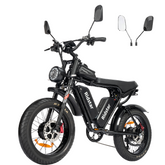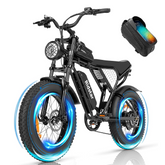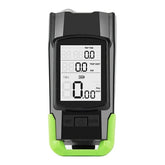Maximize Your Ridstar E-Bike Battery Life
Maximize Your Ridstar E-Bike Battery Life
Expert recommendations and practical advice to extend your battery's lifespan and maintain peak performance for years to come.
Understanding Your E-Bike Battery
Your Ridstar electric bike is powered by a sophisticated lithium-ion battery pack, engineered for durability and performance. Like all advanced batteries, its longevity depends significantly on how it's treated. With proper care, your battery can maintain excellent capacity for hundreds of charge cycles.
Charging Best Practices
How you charge your battery significantly impacts its lifespan. Follow these guidelines to optimize charging:
Avoid frequent full discharges: Unlike older battery technologies, lithium-ion batteries prefer partial discharges. Try to recharge when your battery reaches 20-30% rather than waiting for complete depletion.
Don't always charge to 100%: For daily use, charging to 80-90% is ideal. Reserve full 100% charges for times when you need maximum range.
Use only Ridstar-approved chargers: Third-party chargers may not have the correct voltage or charging profile, potentially damaging your battery.
Allow cooling before charging: If you've just finished a ride, let the battery cool to room temperature before plugging in.
Pro Tip: Charge your battery in a cool, dry place away from direct sunlight. Ideal charging temperatures are between 50°F and 77°F (10°C and 25°C).
Storage Recommendations
Proper storage is crucial when you're not using your e-bike regularly:
Ideal charge level for storage: If storing for more than a few days, charge your battery to approximately 60%.
Store in a cool, dry place: Avoid temperature extremes—never store batteries in freezing conditions or areas that might exceed 95°F (35°C).
Check periodically during long storage: For storage exceeding one month, check the charge level every 4-6 weeks and top up to 60% if needed.
Important: Never store a fully depleted battery for extended periods. This can lead to a deep discharge state that may permanently damage the battery cells.
Usage Techniques for Extended Battery Life
How you ride affects battery longevity more than you might think:
Use pedal assist wisely: Lower assist levels extend battery life and reduce strain on the system. Use higher assist levels only when necessary.
Maintain proper tire pressure: Under-inflated tires increase rolling resistance, forcing the motor to work harder and drain the battery faster.
Anticipate terrain changes: Ease off on throttle before hills and use momentum to your advantage on flat sections.
Reduce unnecessary weight: The heavier the load, the more energy required to move it.
Temperature Considerations
Extreme temperatures are among the biggest threats to battery health:
Avoid riding in extreme cold: Battery performance temporarily decreases in cold weather. If you must ride in freezing conditions, store the battery indoors until ready to ride.
Never leave your bike in direct sunlight: High temperatures accelerate battery degradation and can pose safety risks.
Allow cold batteries to warm gradually: If your battery has been in cold conditions, let it reach room temperature slowly before charging.
Quick Reference Guide
Optimal charging range: 20% - 80%
Best storage charge: ≈60%
Ideal temperature range: 50°F to 77°F (10°C to 25°C)
Maximum storage temperature: 95°F (35°C)
Average charge cycles: 500-1000 before significant degradation
Maintenance Schedule
After each ride: Wipe down battery casing, check for damage
Monthly: Clean contacts with dry cloth, ensure mounting is secure
Every 6 months: Perform a full discharge/recharge cycle to calibrate the battery meter
Annually: Have a certified technician inspect the battery system
Troubleshooting Common Issues
Reduced range: This is normal over time, but if sudden, check tire pressure, brake drag, and ensure you're not carrying extra weight.
Battery not holding charge: May indicate need for replacement, especially if over 3 years old with regular use.
Error messages: Consult your manual and contact Ridstar support if persistent.
Remember: All batteries gradually lose capacity over time. After 2-3 years, some reduction in maximum range is normal and expected.
Ride Longer, Ride Further
By following these expert recommendations, you'll maximize your Ridstar e-bike battery life, maintain performance, and get the most value from your investment. Proper care leads to more adventures and fewer replacements!
Explore Battery Accessories
© 2025 Ridstar E-Bikes. All rights reserved. Always ride responsibly and follow local regulations.
For specific questions about your Ridstar battery, please contact our support team or consult your user manual.













